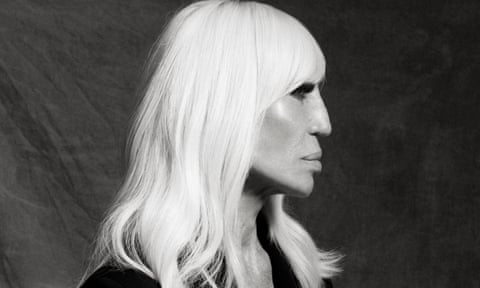Men – particularly wealthy, powerful ones – are often described as becoming more attractive as they get older. You rarely hear it said of a woman, but it is true of Donatella Versace. I am watching her sit for her portrait and marvelling at a face that has the bones of a Roman emperor and the lashes of a Fellini leading lady. Her three-quarter profile could – should – grace a stamp, or a gold coin, or a slope of Mount Rushmore. Her skin, the colour of the terracotta rooftops of Milan, spread out outside the window, is luminous. Vanilla-blond hair falls in a soft wave, lopped off at shoulder blade height. The high slit in her floor-length black dress reveals legs toned so taut that they ripple as she moves. I am watching from the back of the room and when she breaks from posing to greet me, she moves with a lissom grace that belies the seven-inch platforms on which her tiny frame is jacked up.
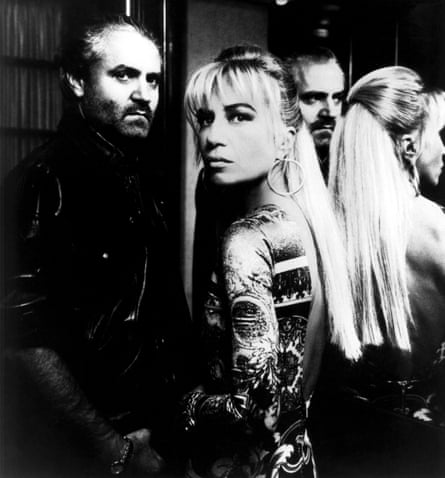
- Designers Gianni and Donatella Versace in the 1970s
At 62, Donatella Versace is artistic director and vice-president of a company with an annual revenue of £592m. Perhaps, then, it is sexist to focus on how she looks. But she brings it up herself, when the photographs have been shot and she and I are sitting on plump sofas in her elegant all-white office. I ask her where her aesthetic came from and she says, “I was not born fantastically beautiful, but I always wanted to be impressive. So I bleach my hair blond, I wear high heels. I am 5ft 2in – me and Bruno Mars, the same – so I wear high heels all the time, to be tall.” Donatella knows it is not trends that drive the fashion industry, but the eternal obsessions of women as they look in the mirror: looking better, getting noticed, feeling good. The visceral, primal stuff. This is why the Versace brand still has potency, 40 years after Gianni Versace opened a first boutique on Via della Spiga, a half mile from where his sister and I are sitting now.
The Donatella who sits opposite me today in her light-filled office is a very different looking woman from the Donatella I first interviewed a decade ago. Her hair then was twice as long and twice as thick, with a heavy fringe that obscured half her face. Her skin had reached that point of mahogany where the glow seems to dim. She was still smoking then, lighting successive Marlboro Reds with hands that trembled a little, so that there was a soft clatter every time she replaced her espresso cup in its lacquered saucer. She was already in her 50s, but I remember thinking that she seemed like a little dauphin prince, dwarfed by the gilt grandeur of her private apartment.
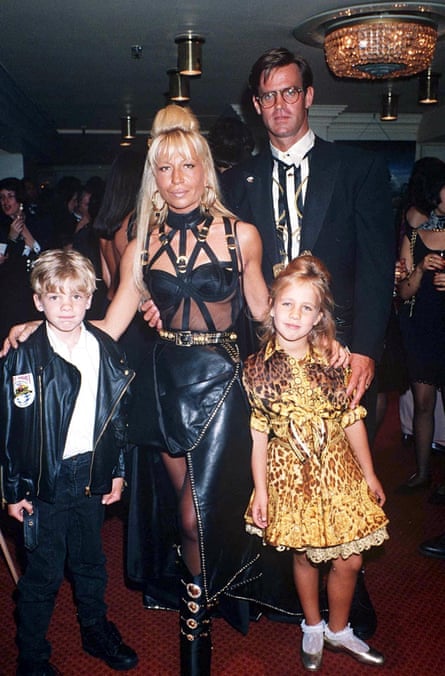
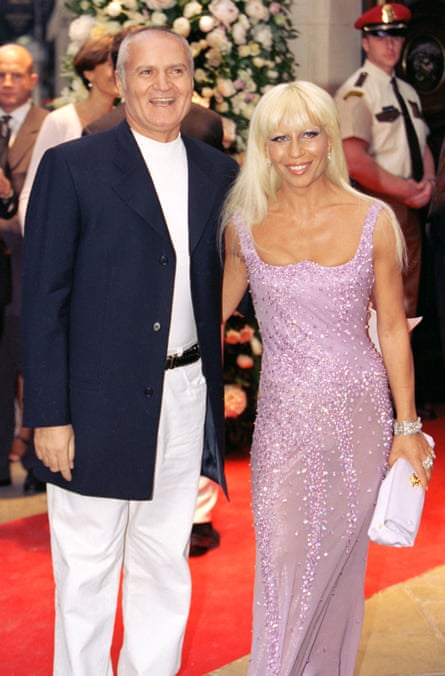
A decade later, she seems so much younger than she did then. The Versace opulence is as deep-pile as ever, with armfuls of peonies and high-end scented candles flickering on every side table. Donatella’s handbag sprawls its contents across a large desk behind her, and the energy around those who work with Donatella is infinitely more relaxed. Sipping water through a straw from a glass etched with a Medusa head, she seems a sunnier person. Only the distinctive rasp of a voice is the same, despite almost a decade as a non-smoker.

- Elizabeth Hurley wearing that dress in 1995
Donatella Versace has proved a lot of people wrong and not least, one suspects, herself. “When my brother was murdered, I had the eyes of the whole world on me and 99% of them thought I wasn’t going to make it. And maybe I thought the same, at first. My brother was the king, and my whole world had crashed around me.” But two decades after the murder of her brother placed Gianni’s sister and muse unexpectedly at the head of the Versace table, she helms a business that, since creaking close to bankruptcy in 2004, has been nursed back to health. A British CEO, Jonathan Akeroyd, was hired from Alexander McQueen last year. The Versace family still owns 80% of the business, with most shares in the name of Donatella’s daughter Allegra, who is now 31. (Allegra’s brother Daniel inherited Gianni’s art collection, which is now worth a good deal more than the £37m it was valued at then.)
The Donatella Versace story began on 2 May 1955, when she was born in Reggio Calabria. Her mother, a dressmaker, would let her baby daughter play in the basket of fabric in the middle of the room as she worked. Her brothers, Santo and Gianni, were 10 and eight when she was born, but her bond with Gianni defied the age difference. “I was his doll and his best friend. He dressed me up in cool clothes, took me out to discos and clubs from when I was 11. I loved it. It was the best time of my life,” she says. Donatella left home for university in Florence, but was soon back by Gianni’s side, and remained there throughout his 90s glory days – supermodels singing George Michael’s Freedom on the catwalk in 1991, Liz Hurley in that safety pin dress in 1994, Madonna shot by Steven Meisel and Mario Testino in 1995 – while Santo ran the business. “There was Santo, the calm one; Gianni, the enfant terrible, and me – Gianni’s accomplice” was how Donatella described the dynamic at the time. She had sole creative responsibility for Versus, the diffusion line launched in 1989.
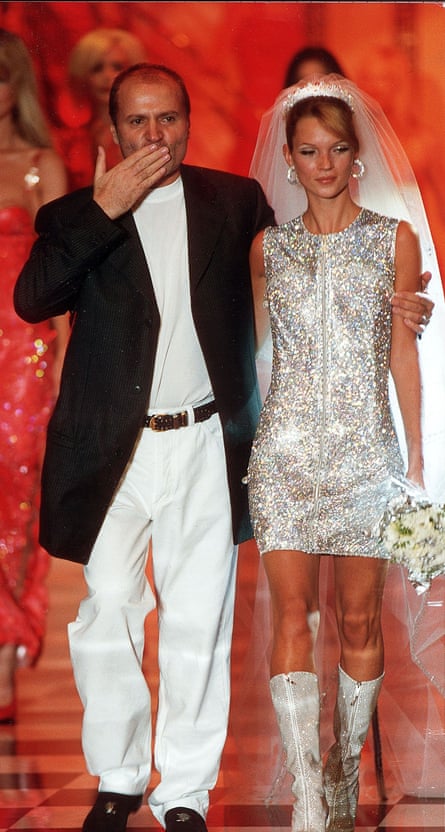
- Gianni Versace with Kate Moss in a sequin mini in 1996.
And then came the second act. Soon after Gianni was murdered in July 1997, it was announced that Donatella would assume creative control of Versace. If Donatella could go back and give advice to her younger self at that moment, she says, “I would say to myself: be strong, and stay true to yourself. Oh, there are a lot of things I would love to say! But most of all, follow your own instincts, and don’t try to be Gianni.” In the years immediately after the murder, Donatella looked at times like a woman overwhelmed. With the Barbie hair and the carefree partying, it was as if she continued playing the role of Gianni’s doll even when he was gone. “For the first five years, I was lost,” she says. “I made a lot of mistakes.” Pole-axed by grief, Donatella was also battling a cocaine addiction that lasted 18 years until she was admitted to rehab in 2005. “Any addiction I have had, when I have ended it, I have done it just like that,” is all she says today, with a dramatic snap of her fingers. “I don’t look back.”
In the second half of the decade, Donatella found her voice. “I had been listening to everyone else, and then I realised, who was the person my brother listened to? Me. I worked with him every day. I was much more than a muse. It was a dialogue between us. We discussed everything.” As she grew in confidence, she began to espouse the language of female empowerment. A 2005 ad campaign starring Madonna, shot by Mario Testino, portrayed Madonna as a glossy, Versace-wearing CEO. “A high-level working woman that does not renounce glamour when she’s in the office,” was how Donatella described it to Italian Vanity Fair at the time. “Madonna worked to define that image: she’s a woman who put her nose into everything that has got to do with her, and that’s smart.”
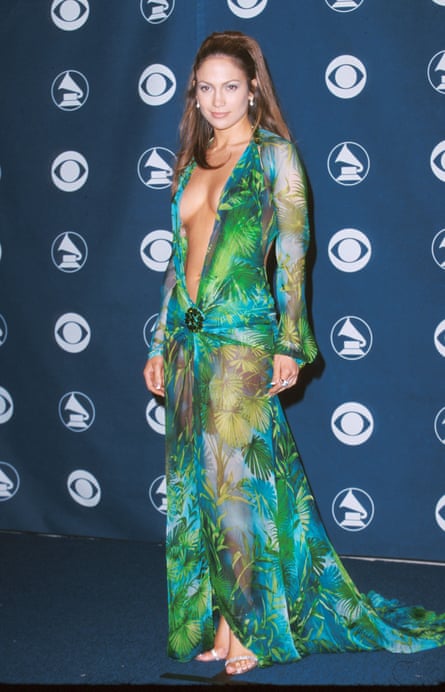
- J Lo at the Grammys in 2000
Donatella’s feminism is heartfelt, if at times eyewateringly unreconstructed. (“Those feminists in the 1970s, marching around with no bras. That’s finished!” she announces gaily today.) The women’s marches in January were emotional, she says, and “a true feminist moment. The whole world was a bit worried about this new president, but who was it on that march? Women! Women have the courage, you see.” The position of women today is “better than it was, but not better enough”, she says. “We need more women in politics, more women CEOs. Women becoming top models, that’s not enough.” Her perspective as a woman has changed Versace, she says, making it both more feminine and more feminist. “Male designers, they love to sketch. I don’t care about the sketch, I care about the fit. I drape the fabric, I try everything on, I work so that when you put on Versace, you feel better. You should feel impenetrable. And that needs to happen for a size 38 and for a size 46.”
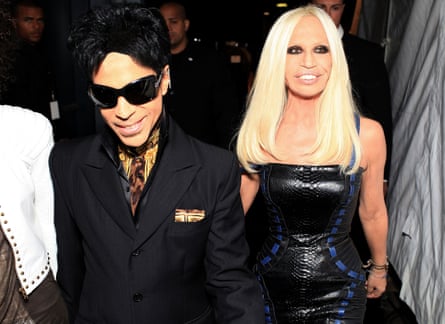
- Versace with Prince at the at the launch of the H&M range in 2011.
In 2008, Donatella Versace hired Christopher Kane to resurrect Versus, which had fallen by the wayside in the aftermath of Gianni’s death. It was the first in a series of close relationships with young designers that have kept Versace fed with creativity and have earned Donatella a place of great affection within the fashion industry, where she is the most glamorous of fairy godmothers. Anthony Vaccarello, now at Saint Laurent, and JW Anderson have at different times brought their visions to Versus collections, while the hot up-and-comer Michael Halpern now consults for the haute couture studio. “I adore [Halpern],” Donatella says. “I say to them, show me Versace through your eyes. I like to surround myself with people who have nothing to do with Versace, so that I can see it how they see it.”
Donatella has both made Versace her own and transcended it. When she – a rival designer – was revealed as the model for a 2015 Givenchy ad campaign, the cool black-and-white headshots portrayed her in a new light: as an icon of female strength, rather than the designer of hot dresses. This was a new Donatella: still blond, still bad-ass, but with an engagement and warmth that had been missing from her public persona as a younger woman. “Now, I feel like the death of my brother made me strong. But for a long time it was a trauma. You know the first thing I did when I heard the news, the day he died? I ran to the room where my children were, to turn off the TV. But I wasn’t quick enough, and they were watching their uncle covered in blood, and they were asking me why. I had to be strong for the company. But most of all I had to be strong for the family. People thought I wasn’t a warm person, but I was just trying to keep myself together.”

- Donatella Versace and designer Anthony Vaccarello on the catwalk in 2014 at the Versus Versace show in New York.
Donatella’s marriage to Paul Beck, the father of her children, ended in 2000. She bats away questions about her private life by saying that she doesn’t have one. At home, she says, she catches up on movies and watches the news on TV. “I need to know what is going on. Fashion processes sociology. You can see everything in clothes.” She tells me she has worked out every single day for 18 years, which must surely be an exaggeration – but not by much, I would wager, judging by her physique. As for what the immediate future holds, all she will say is that, contrary to the rumours that swirled around earlier this year, she will not be handing over creative control to Riccardo Tisci. And then, as befits an emperor, she takes a unilateral decision that the interview is over, and stands to leave. “It’s been fun,” she says. “And now, goodbye!” In her platform heels, she is the height of a supermodel. “Oh, but these are very comfortable,” she insists. Does she always wear heels? “No! At the gym I wear sneakers. And at home I am barefoot. But otherwise, always heels. With me there is no middle way.”
This article appears in the autumn/winter 2017 edition of The Fashion, the Guardian and the Observer’s biannual fashion supplement
